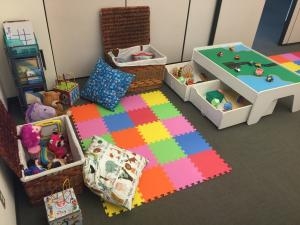(The Keiki Corner at the Ronald T.Y. Moon Judiciary Courthouse in Kapolei.)
By Staff Reports
(Oahu)– Keiki Corner, a class project by UH Mānoa law and education students, has made a big difference for young children at Kapolei’s Ronald T.Y. Moon Judiciary Courthouse, where they wait during emotional Family Court hearings.
Students in the Child Welfare Clinic — a multi-disciplinary class that involves the William S. Richardson School of Law, College of Education and Myron B. Thompson School of Social Work — created a book nook and play area outside the courtroom to entertain youngsters who often wait for hours while their biological and foster parents appear in court.
“We received book donations from Friends of the Library and bought toys, and a lot of people helped to jumpstart the program,” said education graduate student Jacqueline Camit. “We were allowed to set it up in March and it’s been a success. Kids loved it.”
The students created a shelf of books as a “book nook” and brought pillows and mats to make the allotted area homey and comfortable for children. There have been enough books that each child can even take one book home.
The students who worked on the project, including education graduate student Jamie Lyn Leonardi and law school graduate Grace Baehren, remember that the young children they saw were overjoyed. “A lot of them don’t have books at home. They were overwhelmed and happy,” said Baehren. “We wanted to make Family Court more family-friendly.”
Judges have been greatly impressed with the results. Judge Paul Murakami said that the partnership with UH students and the courts has been very rewarding. It’s a tremendous way to help the children as they wait, Murakami told students and faculty during a session at the law school when students in the clinic presented their completed projects. “These hearings are often the only chance they have to see each other,” he said.
Court personnel have commented on how rewarding the book nook has already become. One Family Court facilitator explained that children were excited to have one-on-one time with their moms as they sit and read together. Judge Murakami recalled that, in one of the families whose children have been separated, the older sister beamed as she sat down to read to her younger sister.
Instructor Jane Dickson Iijima, who has been involved with the clinic from its inception, says it offers tremendous value to the children it helps, as well as the students who plan the projects. “To have this wider picture is very important for both,” said Dickson Iijima. “I feel like all the students learn from what each of the different disciplines know best. And you can see where your gaps are. Teachers have an insight into a certain part of a child’s life, and law students have insight into the court system and what works best there, so the knowledge gets spread out. And when they talk together, new ideas come up, too.”
Dickson Iijima said this project was a true combination of the strengths of law and education, with the educators understanding “that little children need to be exposed to books early, and law students recognizing that when court cases are involved, there can be a lot of waiting.” Working together, she said, “they came up with the idea that wouldn’t it be great to have a comforting, welcoming space for kids where they can wait with siblings and other family members.”
Although the initial clinic project has been completed, the clinic students raised enough to add two other Keiki Corners at the Kapolei judicial complex. The students hope to do more, such as expanding the project by assembling books for older children, as well as creating a children’s play area outside.
Two Neighbor Island judges heard about the Keiki Corner and may be planning to take the idea back home to their courts, according to Dickson Iijima. “I think it’s going to spread,” she said.
The Child Welfare Clinic has been a powerful resource for many non-profit community groups over the past decade, in addition to agencies of the court system. Students have worked to help young offenders understand street law, for example, as well as numerous other projects to improve the lives of children at risk.
“The idea was to have a class that attacks complex social issues,” said Law School Dean Avi Soifer of the multi-disciplinary clinic that brings together graduate students from several disciplines as well as providing tangible benefits to the community.
“As you push budding professionals into a course like this, you encourage them to look outside of their own disciplines and to learn the strengths and weaknesses of their own disciplines as well as of those with whom they are collaborating,” added Soifer. “Further, in a place like Hawaiʻi, graduates of the program will have an invaluable network of other professionals who can help each other over many years.”

